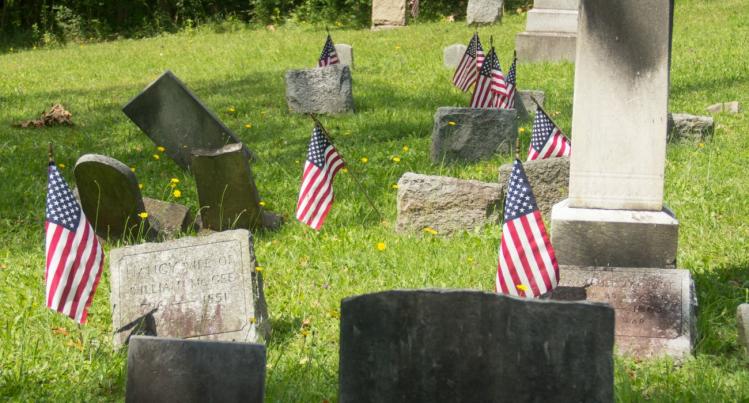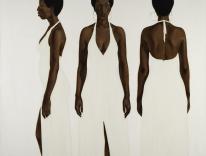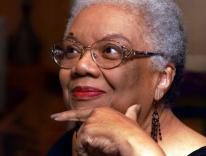
Lugged from creek bottoms to be chiseled and laid flat against the hillside, the stones held warmth well after sunset and made good places for prone stargazing, a pastime enjoyed by children before the era of computers and cell phones. I imagine a certain boy asking a friend if he knew which one was the North Star. After his friend said no, the boy pointed and said your gaze should follow the outer edge of the Big Dipper from the bottom to top of the bowl and continue in that direction until reaching the first bright star. I imagine also that, because of certain names chiseled into the stones and because of the bones below, he added that there used to be men and women who would find their way to the North by following that same star, their Star of Bethlehem, while they were trailed by other men who possessed hounds, rope, shotguns, and white skin.
To find the stones you need to poke and kick at the hillside with your shoes, because the markers are now covered by sod. The other markers in the cemetery, more numerous and on the higher and fairly level ground, were cut from marble or granite rather than shale and are still exposed to the light. The higher dead are sometimes honored with flags and flowers.
Yankee Hill Road is subject to flooding where it passes the cemetery, but each of the cemetery dead was given a dry enough resting place. In that sense, the dead are equal. At an altitude of two thousand feet, Yankee begins abruptly its two-mile fall to the base of the cemetery, the terrain forested and sloping away from the shoulders in a snaky vee. More than once I’ve helped drivers who lost control of their vehicles and ended up in the stony ditches or dense woods along the road, and I myself have had several close calls with deer and once a bear jaywalking on Yankee. In August 2003, heavy rain filled the ditches and spilled into the road, muddy water hastening and swelling as it fell, sweeping chunks of macadam past the cemetery and into the flatland, eye-blink center of a township with the Native American name of Ischua. When correctly pronounced the name sounds like the lisping hiss of fast water: Ish-oo-way. Luckily for the living, who had mostly forgotten the dead, none of the flooding reached even the lower graves—no bones were delivered to town.
It was in the midst of a drought when Ischua resident Cliff Lowe told me a story about the stones. He was by then retired, but a lifetime ago, before he began earning his living variously as a fur trapper, truck driver, welder, and electrician, he wondered about the hillside stones from which he stargazed. The chiseled names “sounded different,” he told me. Around town, teenage Cliff began to ask about the names. He first heard the story of the stones from Theo Clayson, who was an occasional gravedigger back before Cliff was born. Ischua had once included two small settlements of African Americans, according to Clayson. Both settlements were established on leased land near grist and lumber mills on Ischua Creek, and the renters dwelled in wooden shacks. Some worked for the mills and most of the families, like the Irish Catholics in English-occupied Ireland, cultivated and largely subsisted on potatoes. Clayson didn’t know when or why African Americans first settled in the town. Did they come north on the Underground Railroad, traveling against the currents of the Ohio and Allegheny, intending to reach Buffalo by foot or horse and somehow cross the Niagara into Canada? Did they instead put down roots near Ischua Creek when mill owners, whether sympathetically or exploitively, offered them work and a place to build? In other words, were they somewhat like many of the immigrants who today find their dangerous way into the United States? Or had they labored on the crews that dug the Genesee Valley Canal through the region? Clayson didn’t know, and neither did Ray Chambers, another old-timer, who told Cliff more or less the same story about vanished settlements of African Americans.
What Clayson knew firsthand is that because African Americans were denied burials in the higher, flatter portion of the cemetery, their graves needed to be dug into the hillside—“into” because the slope was so steep. The wooden caskets “were almost standing up” when covered by Clayson. He said he dug often during a typhoid epidemic that decimated both African-American communities early in the twentieth century, earning “good money for those days,” maybe more than some of the dead had touched during their entire lifetimes. After the epidemic, the surviving residents of the settlements dispersed, abandoning their homes. Where did the people go? No one knows.
Supposedly one of the settlements was located on now generally abandoned Baxter Mill Road. Locally, the road is known as Suicide Hollow because, as I’ve been told by a couple of my neighbors, “some people committed suicide in there.” No one has been able to tell me who, or when, or how, or why.
Cliff used to trap and hunt in Suicide Hollow and can recall seeing punky boards and timbers, rusty pots, jars emerald with moss, and the humpy overgrown rows of a former potato field. Yet I can find no written record of a settlement there. In 1994, Sally Pettengill, town historian at the time, self-published a 289-page history of Ischua, but her book makes no mention of African Americans other than those passing anonymously through town on the Underground Railroad. I notice no name that is “different” in the cemetery records, but perhaps that is because no one with such a name was buried in the upper cemetery. I asked Rose Edwards, our current town historian about Cliff’s story, and although she can speak knowledgably for hours about local history, she had heard nothing about any African American community in Ischua. Yet she remembers the hillside gravestones, some of which were still exposed to the sun when she was a girl. She says she “always wondered why people were buried on such a steep place.”
Edwards could tell me, though, that several years ago a man was remodeling a home in Ischua, built for a white doctor in the nineteenth century, and in one wall discovered an old photograph of “a black woman and some love poems.” Today, nobody knows why the photo and poems were hidden in a wall or who the woman was.
In February 2017 it was reported that a decade earlier, when she was in her sixties, Carolyn Bryant admitted she had fabricated the story of Emmett Till grabbing and harassing her in August 1955. A couple of days after the confession was first in the news, I was on a bar stool sitting next to a guy who said he was relieved he could retire soon, both because of his bad knees and because of his fear that before long the knife plant would close. He felt bad for the younger guys. Between beers and trips to the urinal he started reminiscing about better times and then sang with modest talent two verses of a song by Mary Hopkins: Those were the days, my friend / We thought they’d never end. From a nearby table, a man and woman clapped, and now, in the sepia of my memory, I see the couple through a haze of stratified smoke, leaning over the small table, grey heads nearly touching, applauding—but that can’t be right, because New York State no longer allows smoking in bars. On our stools, my new acquaintance and I continued to converse, and eventually, because I couldn’t stop thinking about a recently reprinted photo of a tortured and murdered boy, I brought up Bryant’s confession. But the nice guy next to me didn’t seem to know who Emmett Till was. That same evening, I asked two other people. One knew.
Maybe because I’m no longer as sure as I once was about what I know or believe, I have developed a habit—a sort of nervous tic—of asking people what they know and believe. I know many people who voted for our new president, including some of my kin, and I ask them if they believe him when he says things such as that Mexico doesn’t “send” its best people here, but sends rapists; that crowds of Muslims cheered in New Jersey when the Twin Towers collapsed; that he will “send” the Feds into Chicago to end its gang killings; and that far from being a killer, Vladimir Putin is a “good guy.” Some say sure they do; some say not all of it; some say not really. And then some ask me: But what politician can we believe? What can we believe? Can we believe anything any longer? I study them, and I’m not sure whether they do or do not believe the things the president has said and whether they do or do not believe we can’t believe anything. And who are we, we who can’t believe anything any longer? I try to remember. I draw a blank.
On September 28, 2015, the Alleghenies rippled beneath a blood moon. Colored by the Rayleigh scattering of light during some lunar eclipses, blood moons are not extremely rare, but the one in September nonetheless caused a tide of anxiety in many fundamentalist Christians familiar with a prophesy in the Book of Joel: “The sun will turn into darkness, and the moon into blood, before the great and terrible day of the Lord comes.” The popular ministers Mark Blitz and John Hagee had widely disseminated their theological conclusion that the blood moon of September 28 would be the Big One, as people out in California refer to the earthquake that might one day dump much of the West Coast into the Pacific. Hagee’s book on the prophecy reached number four on the New York Times bestseller list, demonstrating anew that ambulance chasing is a lucrative business.
As the night of the blood moon approached, one of my neighbors, a Christian fundamentalist, became, well, apocalyptic. “Something terrible is gonna happen,” he warned in his front yard. “Something really terrible.” As if he had forgotten I was present, he began to pace the lawn.
I thought the scarlet moon beautiful even though, disconcertingly, it looked as if covered by a translucent, fragile membrane—calling to mind a blood blister on a healing injury or an imminent aneurism. Beyond the cast of incandescent light from my home, I gazed into the sky from the dock of my pond, but I now wish I had traveled Yankee Hill Road, parked my pickup, climbed part way up the slope of the cemetery, and lain back over a sod-covered gravestone polished centuries earlier by the unbroken flow of a creek. Maybe there, under the breathtaking sky and above old bones, I would have felt hopeful, since all of us exist beneath the same firmament and shall be reclaimed by the same earth, before which, in our brief lifetimes, we perhaps can come to relish our mutual humanity. Then again, I might have felt something terrible is gonna happen.
Please email comments to [email protected] and join the conversation on our Facebook page.
Share
Previous Story
Four Poems by Micheal O’Siadhail
Next Story
The Catholic Sister Who Challenged Paul Ryan on CNN

